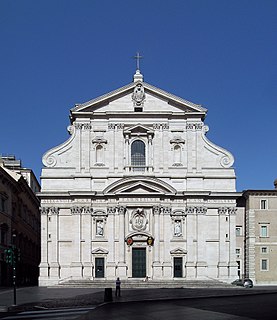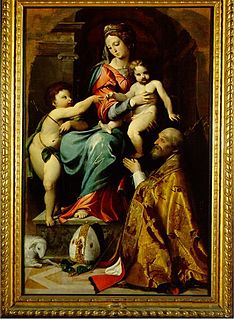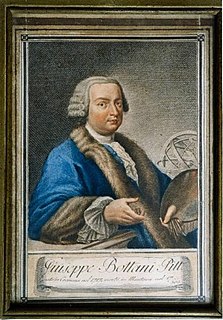Related Research Articles

Amilcare Ponchielli was an Italian opera composer, best known for his opera La Gioconda. He was married to the soprano Teresina Brambilla.

Cremona is a city and comune in northern Italy, situated in Lombardy, on the left bank of the Po river in the middle of the Pianura Padana. It is the capital of the province of Cremona and the seat of the local city and province governments. The city of Cremona is especially noted for its musical history and traditions, including some of the earliest and most renowned luthiers, such as Giuseppe Guarneri, Antonio Stradivari, Francesco Rugeri, Vincenzo Rugeri, and several members of the Amati family.

The Church of the Gesù is the mother church of the Society of Jesus (Jesuits), a Catholic religious order. Officially named Chiesa del Santissimo Nome di Gesù all'Argentina, its facade is "the first truly baroque façade", introducing the baroque style into architecture. The church served as model for innumerable Jesuit churches all over the world, especially in the Americas. Its paintings in the nave, crossing, and side chapels became models for Jesuit churches throughout Italy and Europe, as well as those of other orders. The Church of the Gesù is located in the Piazza del Gesù in Rome.

The Basilica of San Petronio is a minor basilica and church of the Archdiocese of Bologna located in Bologna, Emilia Romagna, northern Italy. It dominates Piazza Maggiore. The basilica is dedicated to the patron saint of the city, Saint Petronius, who was the bishop of Bologna in the fifth century. Construction began in 1390 and its main facade has remained unfinished since. The building was transferred from the city to the diocese in 1929; the basilica was finally consecrated in 1954. It has been the seat of the relics of Bologna's patron saint only since 2000; until then they were preserved in the Santo Stefano church of Bologna.

Giovanni Francesco Bembo was an Italian Renaissance painter from Cremona, mainly active from 1515 to 1543. He apprenticed with Boccaccio Boccaccino. In 1515, he painted two frescoes: Presentation in the Temple and an Adoration of the Magi for the Duomo of Cremona. He painted an altarpiece for San Pietro depicting a Madonna with three saints and a donor in 1524. In 1530, he painted a Madonna with Saint Stephen and in 1540, a Madonna with St. John the Baptist and a Bishop now in the Museo Civico.

Antonio Zanchi was an Italian painter of the Baroque, active mainly in Venice, but his prolific works can also be seen in Padova, Treviso, Rovigo, Verona, Vicenza, Loreto, Brescia, Milano, and Bergamo, as well as Bavaria.

Grazio Cossali, sometimes called Orazio Cossali was an Italian painter who worked in Brescia, Cremona, and Venice, active during the Mannerist or early Baroque periods.

Giovanni Battista Trotti was an Italian painter of the late-Renaissance period, active mainly in Piacenza, Parma, and his native city of Cremona.

Giovanni Giacomo Barbelli was an Italian painter of the Baroque period, active in Lombardy. He was a canvas and fresco painter known for his religious and mythological scenes that decorate many churches and residences in Lombardy. He was a highly skilled draughtsman and a brilliant colorist. His work shows an inventive imagination and a thorough knowledge of perspective.
Antonio Beltrami (1724–1784) was an Italian painter active in the late-Baroque and Neoclassic periods. He was born in Cremona. He was a pupil of Francesco Boccaccino, who emerged from the school of Carlo Maratta. His older brother, Giovanni Battista was an engraver.

Giuseppe Bottani was an Italian painter active in the Baroque period.
Giuseppe Tortelli was an Italian painter of the late-Baroque period, active in Brescia.
Enrico Scuri was an Italian painter, active in a Romantic style.
Pietro Francesco Caccialupi was an Italian painter.

Pompeo Marino Molmenti was an Italian painter.
San Francesco di Paola is a Baroque style, Roman Catholic church located on Via Manzoni in Milan, Italy.
Francesco Darosio was an Italian painter and engraver, active in Cremona and Rome.
San Giorgio is a late-Renaissance-style, Roman Catholic parish church located in Casalbuttano, Province of Cremona, region of Lombardy, Italy.
San Marcellino, also known as San Marcellino e Pietro, is a Baroque-style, Roman Catholic church located on Via Ponchielli in Cremona, region of Lombardy, Italy.
Giovanni Battista di Giovannofrio, also known as Giovanni Battista di Norcia was an Italian painter, active in a Renaissance style. He is the brother of the painter, Giacomo Giovannofrio.
References
- ↑ Encyclopedia Trecanni, Dizionario Biografico degli Italiani - Volume 60 (2003), by Maura Picciau.
- ↑ La pittura cremonese, by Principe Bartolommeo de Soresina Vidoni, page 141-142.
| | This article about an Italian painter born in the 18th century is a stub. You can help Wikipedia by expanding it. |